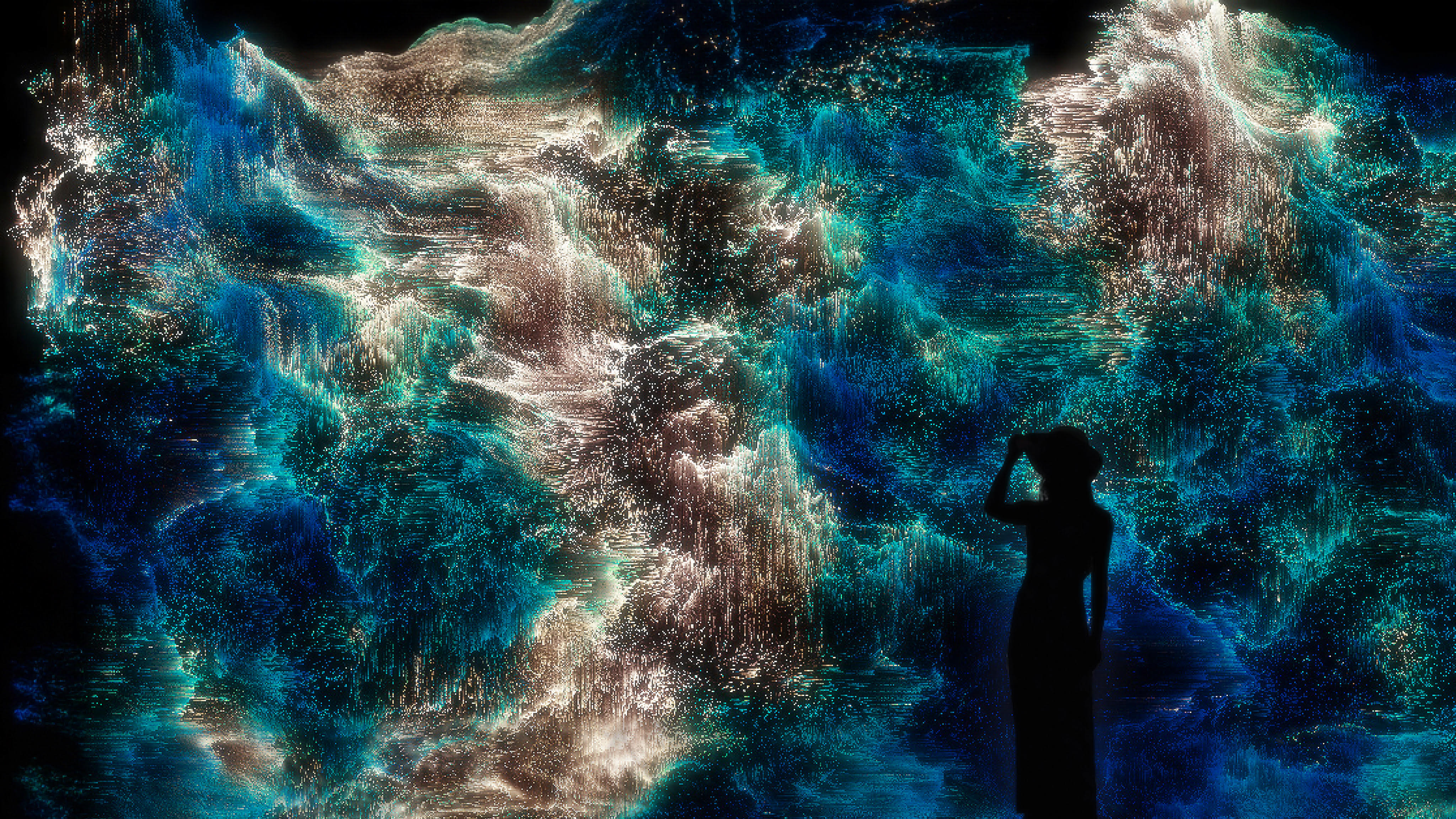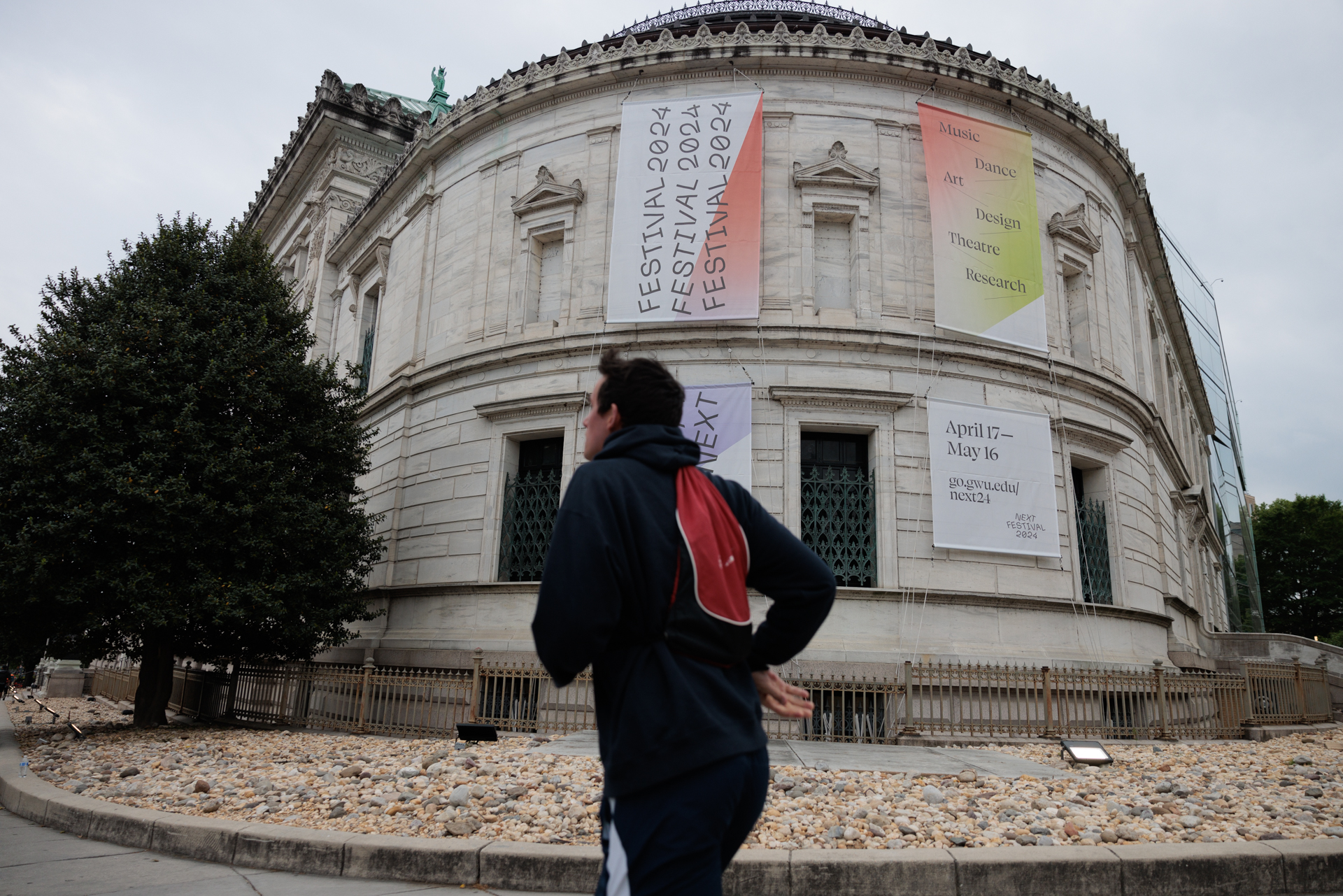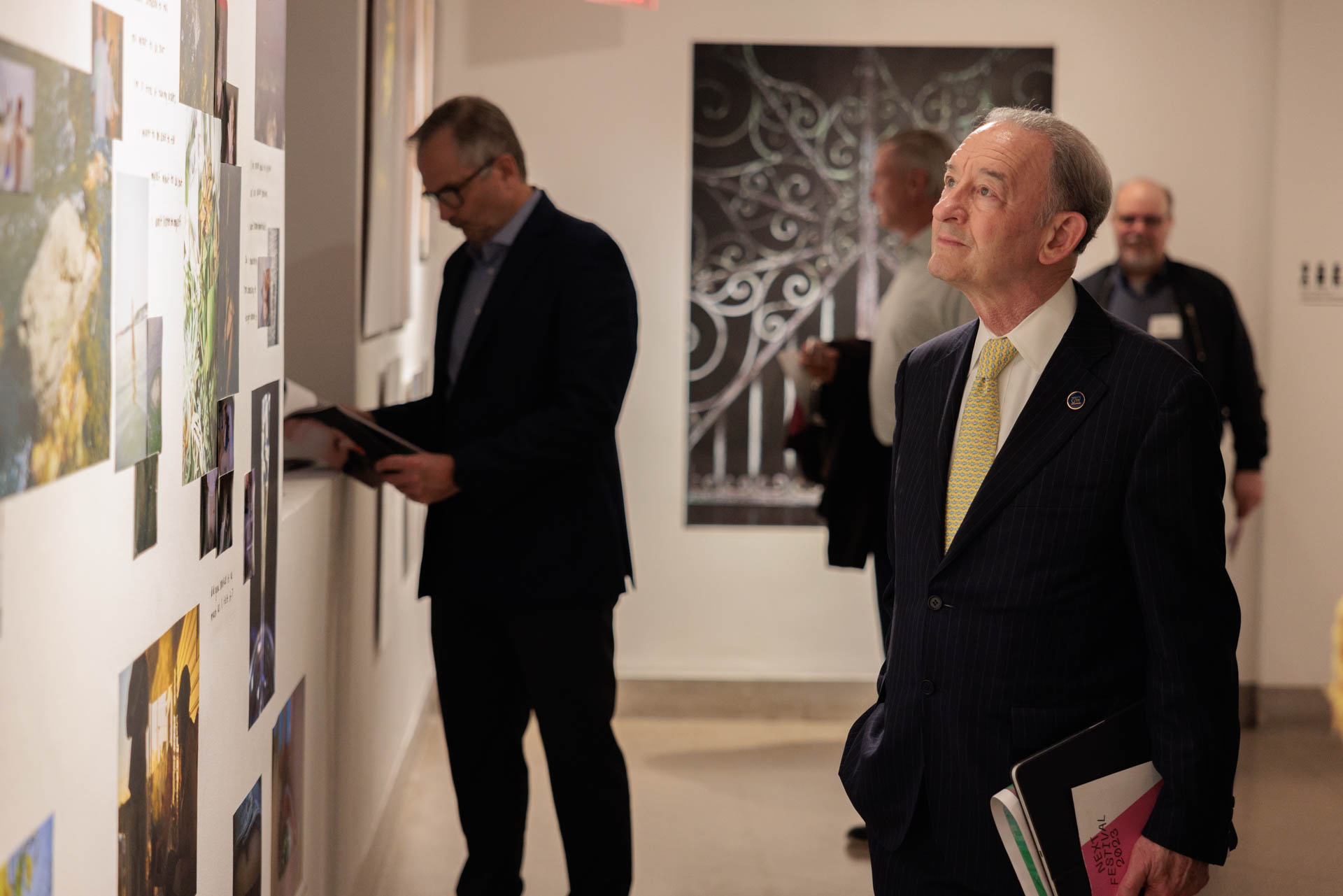Do you hear what sounds like an orchestra tuning up? That’s a metaphor Lauren Onkey, director of the George Washington University Corcoran School of the Arts and Design, suggested to describe preparations for the annual NEXT Festival. Each spring, graduating students in the Corcoran School, housed in GW’s Columbian College of Arts and Sciences, present their capstone projects in a weeks-long celebration lasting through Commencement.
“It’s like music that is coming up slowly to full volume,” Onkey said, as the school hummed with activity in the days and weeks leading up to the festival’s kickoff event, a dance concert in the Dorothy Betts Marvin Theatre April 17–19.
This year’s festival showcases the work of more than 170 students from artistic disciplines across the curriculum, in fields ranging from music, theatre and dance to photojournalism, visual arts and art history. There is no charge for festival events, but festival organizers at the Corcoran School, request that people register online for any events they plan to attend. Members of the GW community, their parents and families are welcome, as are members of the general public.
Now that the renovation of Flagg Building has been completed, the full Atrium, including its second-floor “bridge,” will be available for use by students exhibiting in the festival. Several galleries on the second floor are also newly available.

On the second-floor "bridge" above the Flagg Building Atrium, images wait for viewers. (William Atkins/GW Today)
“Students have really taken advantage of space and thought a lot about flexing their artistic muscles around scale,” Onkey said, noting that she feels a special kinship with this year’s graduating students, since they all came to the Corcoran at the same time.
“These students were first-year students in my first year, so we are kind of graduating after four years together,” she said. “That fall of 2021, when most of them started, they had been in remote learning situations. And seeing them over the course of their time here continue to sort of step out and embrace the value of being and making in community, connecting with one another, thinking across disciplines, has really been remarkable.”

Visitors to the NEXT Festival exhibition can pause for a colorful view in the Atrium. (William Atkins/GW Today)
Onkey has enjoyed watching students navigate in a building that has been under renovation.
“It’s fun and really rewarding to see them now kind of have the whole building to create in,” Onkey said. “In some ways, they’re working without models or precedents, because they are in spaces they have not seen art in. So, these students are really ‘making their mark’ on the building. That’s a great model for students behind them.”
The annual Extravaganza, a huge party that opens the exhibitions in the Flagg Building, will be held in the Flagg Building on April 24. One of the many must-see attractions this year, Onkey said, is an exhibition created by a group of Museum Studies students, located in the first-floor Luther W. Brady Art Gallery.
“It's a photography exhibit called [Un]Framed: Indigenous Peoples and Lands in Focus,” Onkey said. “The students have looked at prints in the GW collection that were taken in the 1870s and 80s on expeditions, the work of two photographers, William Henry Jackson and John K. Hillers. The students curated this exhibition in consultation with the Zuni and Hopi tribes and the Diné Nation, all of whom have ancestors pictured in the photographs.”
All of the materials used to promote this year’s festival—signage, banners and digital elements—were designed by students.
Many of the students are interested in questions of identity and its representation, Onkey said. Some are showing work that explores their own histories, while others have studied communities to which they themselves may not belong.
“We have a student in New Media Photojournalism who’s done a photo and video exhibition about the role of immigrants in the construction industry in Florida, where she's from,” Onkey said. “She has also created an installation of a mini construction site, where you see a wall that is partially built and tools that contractors would be using, and there's even a sonic installation in that space where you hear the sound of a construction site. She has created an immersive experience. I think those kinds of things often become possible when we have more space available.”
Design students have created an installation that is a re-imagination of a transportation system. Exhibitions will feature the work of students of fine arts and interior architecture. Musical and theatrical performances will be given and student research will be presented. Symposia and talks will provide insight into contemporary artistic practices and research.

Hung Nguyen created directional signage for an imaginary rail network. (William Atkins/GW Today)
The NEXT Festival Exhibition will be open at the Corcoran’s Flagg Building, located at 500 17th Street NW, from April 24 through May 16, with galleries open to the public Wednesday through Saturday, 1-5 p.m. For more information about the festival and to register for events, visit https://corcoran.gwu.edu/next-festival.
GW Today asked a group of students to describe the work they will be presenting at the festival. Their responses are shown below.
Shatha Abushaikha, M.A. Exhibition Design
For NEXT 2025, I am curating, designing, and installing an exhibition titled “Veiled Perspectives: The Fear of Modest Form.” This exhibition will highlight the stereotypes placed on veiled Muslim women by the Western gaze, showing the veil as something to be feared. I took a lot of inspiration from Christo and Jeanne-Claude, an artist couple from the mid-20th century, who wrapped nearly everything and anything. I found something so enticing and mysterious about wrapping items, diluting their form, and forcing a singular perspective. With this exhibition, I'm drawing from that approach to show how fabric can both reveal and conceal, beautify and intimidate, and turn the formal body that we understand into something that we no longer do. Tying everything together is the concept of modesty, which drives how the fabric frames form, showing that just because we can’t process what we see doesn't mean it is something we should fear.

Shatha Abushaikha's installation is shown in progress. (Contributed photo)
Ana Arledge, B.A. Dance
During the NEXT Festival, I’m presenting a thesis exhibition and choreographic work that explores Merce Cunningham’s lasting influence on contemporary dance. My project investigates how Cunningham’s once-radical movement vocabulary—marked by clarity, unpredictability, and formal rigor—is preserved and reimagined today through archival research, embodied practice, and original choreography. As part of this process, I engaged with the Cunningham Technique and worked closely with former Cunningham company member Silas Riener to restage solos from “Scramble” and “Signals.” I also created a new choreographic work titled “Pentaxis,” developed in response to Cunningham’s methods and performed by dancers from the Corcoran School. The project is about honoring Cunningham’s legacy while asking what it means to carry it forward and how contemporary voices can move through and beyond traditional frameworks. “Pentaxis” will premiere in SPACE // TIME, a shared thesis performance with Madison Domanski, on May 1.

Ana Arledge, foreground, rehearses her piece "Pentaxis" with sophomore Penelope Arthur. (Contributed photo)
Daysia Barr, M.F.A. Fine Arts
"Gay things and where to find them” is all about finding modes of representation that do not put queer people in danger. The heightened visibility that the community is experiencing right now can be positive, but raising awareness also raises homophobia and transphobia. I began this project to provide my queer friends with a safe outlet for expressing themselves. By taking walks and having them take pictures of everything they saw that looked gay, I amassed a collection of images that portrayed my friends without revealing their identities. Hanging the prints of their photos for an audience asserts that representation does not have to be transparent to be appreciated and accepted.

Daysia Barr explored safe ways to represent queerness. (Contributed photo)
Calie Champaux, B.A. Dance
My work in the NEXT festival represents the culmination of eight months of research into how consumption practices shape self-expression while also reinforcing cultural hierarchies. This academic research is being brought to life through a performance that draws inspiration from the queer, performative legacy of the runway. By blending historical context, critique, and personal narrative, the piece invites audiences to consider fashion not just as aesthetic, but as a powerful, transformative tool of identity and resistance.

Calie Champaux, foreground with her back turned to the camera, gives her cast notes in rehearsal. (Photo by Hayley Ferguson)
Loralei DiFlorio, B.F.A. Graphic Design
My NEXT exhibition is an entirely new visual identity for the state of North Dakota. It is a culmination of all the research I have done this year on the process of designing identities for geographical locations. These identities aim to represent the history, culture and landscape of a place through one cohesive design system. I have not been to North Dakota and neither have a lot of people because it is one of the least visited states in the country. However, graphic design has the power to shape our perception of a place. Though the goal of my designs is to create an identity that will resonate with everyone across North Dakota, I hope it also shines a spotlight on the state for people who may not have paid much attention to it in the past.

These images were designed by Loralei DiFlorio as part of a visual identity system for the state of North Dakota. (Contributed photo)
Emily Greenup, B.F.A. Graphic Design
My thesis, “Artifacts of Identity,” aims to express how graphic design and cultural identity are intertwined and explores how design can communicate cultural identity. I conducted research on a variety of cultures and native designers in order to formulate my own design system for my cultural identity. As a second-generation immigrant from suburban Pennsylvania, I have struggled to connect with my Cuban-Uruguyan background. The result of my research is a hand-built pop-up shop constructed from interlocking cardboard circles, designed to showcase “artifacts of identity.” These artifacts include posters, a custom domino set, produce stickers, zines, and notebooks—each one handmade and designed to reflect elements of my cultural identity. I hope to inspire onlookers and other designers to utilize the field to navigate the uncertainties of identity and cultural connection.

Emily Greenup's "Artifacts of Identity" project explores how graphic design and cultural identity are intertwined. (Contributed photo)
Hung Nguyen, B.F.A. Graphic Design
My NEXT installation is called “Sunchaser,” a brand design for an imaginary high-speed rail network across the United States. You can expect an immersive space of designed signs, maps, and a soundscape that mimics the atmosphere of a train station. The designs aim to visualize what public transportation in the United States could look like, and I hope to bring more eyes to the state of American public transit in the current day. It’s been a rewarding experience experimenting with graphic design in the context of transportation. My peers have explored many other niches and expressed their unique design styles as well. Please check it all out!

Hung Nguyen created a brand design, including directional signage, for a high-speed rail network. (Contributed photo)
Gabriela Passos, M.A. New Media Photojournalism
“Building in America” is a multimedia project that really looks at the housing crisis—not just the lack of affordable homes but all the interconnected issues around it. Each part of the project tries to take on a different layer, from the labor shortages in the construction industry and the industry’s struggle to recruit young Americans to the flaws in our immigration system that make it so the people who are building our homes have to do so in the shadows. To me, this project is about connecting the dots and showing how these big systemic issues impact both the lives of Americans and immigrants.
This project is very close to home for me. Shortly after we immigrated to the United States from Brazil, my parents started working in residential construction, so I grew up going to job sites, helping with demolition, and learning about all the different nationalities whose labor is the backbone of the American construction industry. From the moment I decided I wanted to do this project, I knew that I wanted to build something in my installation. On a personal level, it just felt like if I was going to do a story about labor, then I, too, needed to put in the work. During NEXT, I will be asking other immigrants in the DMV community to contribute their perspectives on what it has been like to build a life in America.

This is one of 16 prints that Gabriela Passos included in her exhibition space. (Contributed photo)
Dylan Reynolds, M.F.A. Fine Arts
“Let’s Rage” is an immersive installation that reclaims rage as a powerful tool for healing and transformation. It's a mixed media installation and is meant to be interactive. The centerpiece of the installation is a set of two double bunked dorm beds, fitted with my red “rage pillows” on the bottom bunk, and a navy comforter cover on top. The shredded paper piles around the beds are the accumulation of rage, collected from members of the community who responded to the prompt, "What makes you rage?" Visitors to the gallery have the opportunity to respond to the prompt as well, writing and shredding their rage, and then adding it to the piles around the room.
By stuffing rage into luxurious, touchable forms, I challenge societal perceptions of rage as purely destructive. Instead, rage becomes communal, cathartic, and restorative. Viewers are encouraged to sit, reflect, and even contribute their own rage, making the space an evolving site of solidarity and shared empowerment. Through this participatory approach, "Let’s Rage" transforms private pain into collective action and reimagines rage as a vital force for societal and personal healing.

Dylan Reynolds created a mixed-media installation titled "Let's Rage." (Contributed photo)
Emily Springer, B.F.A. Fine Arts
My curiosity lies in the dynamic between history and cultural memory. As a Black woman, I reflect deeply on the meaningful relationships between successful, loving, and inspiring women that have shaped who I am. All of these collective stories surrounding the identity of the Black woman manifest the notion of the Black Matriarchy. My work reflects generational bonds that venerate unity, strength, and compassion. The piece will be a sewn tapestry depicting an elderly woman and a middle-aged woman quilting together, while a young girl cuddles the quilt to her face. The embroidered scenes within the patchwork of the quilt represents the vast experiences that Black women collectively share. The flowing embroidery brings aesthetics from the Black cultural practice of needlework passed down through lineages. The use of these motifs strengthens the significance of honoring the past generations in which Black women have continued to rise against all odds.
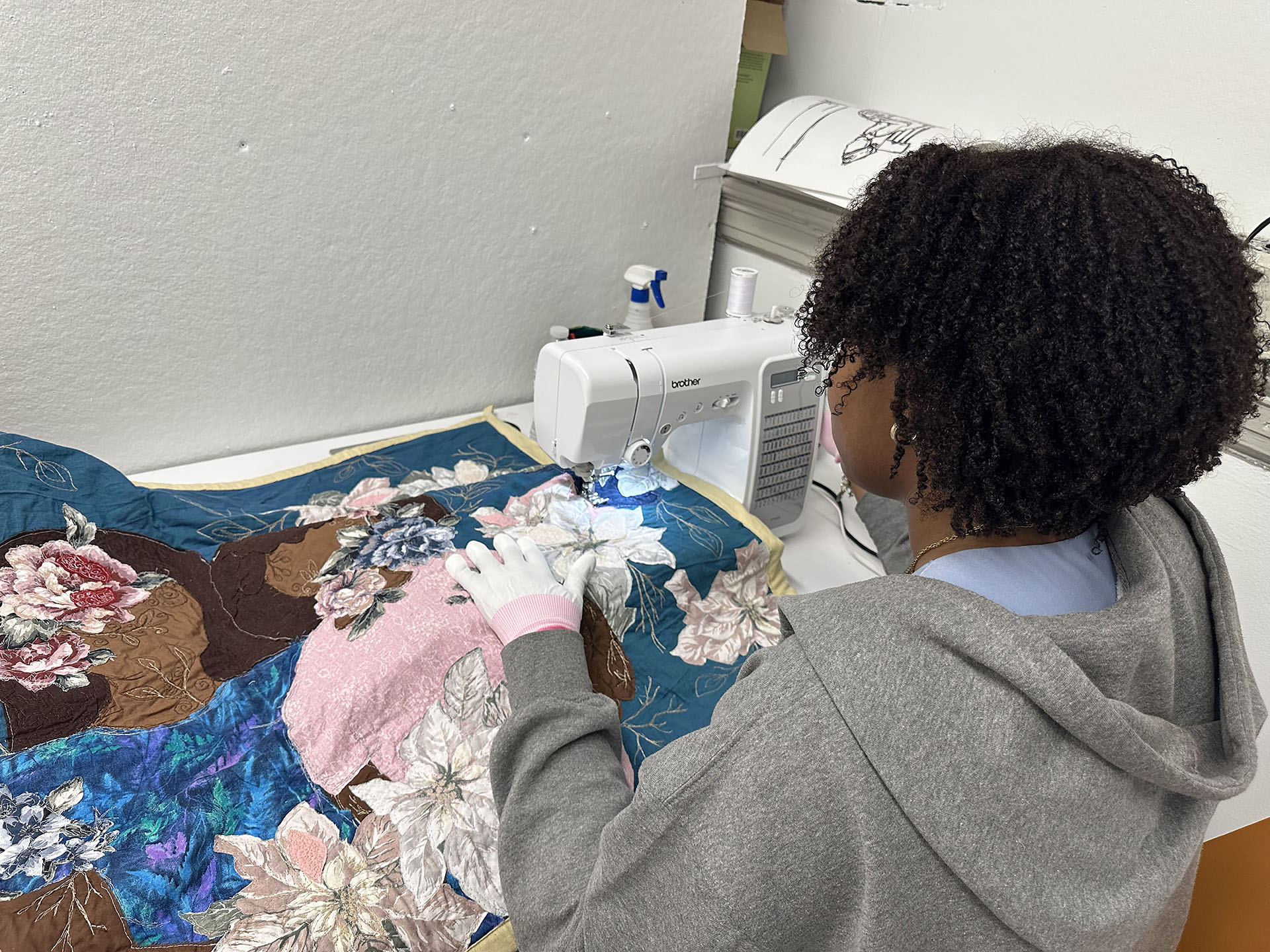
Emily Springer created a tapestry celebrating connections between Black women across generations. (Contributed photo)
Kobe Stewart, B.A. Fine Arts
I will be installing a large-scale multimedia work that explores themes of tension, ambivalence and constraint shaped by intersecting identities within different environments. Informed by personal and collective experiences, the installation reflects on how identity is formed, challenged and contained by the spaces we occupy. Through spatial interventions and the layering of materials, the installation invites viewers to consider the emotional and psychological weight of navigating systems that both define and restrict.
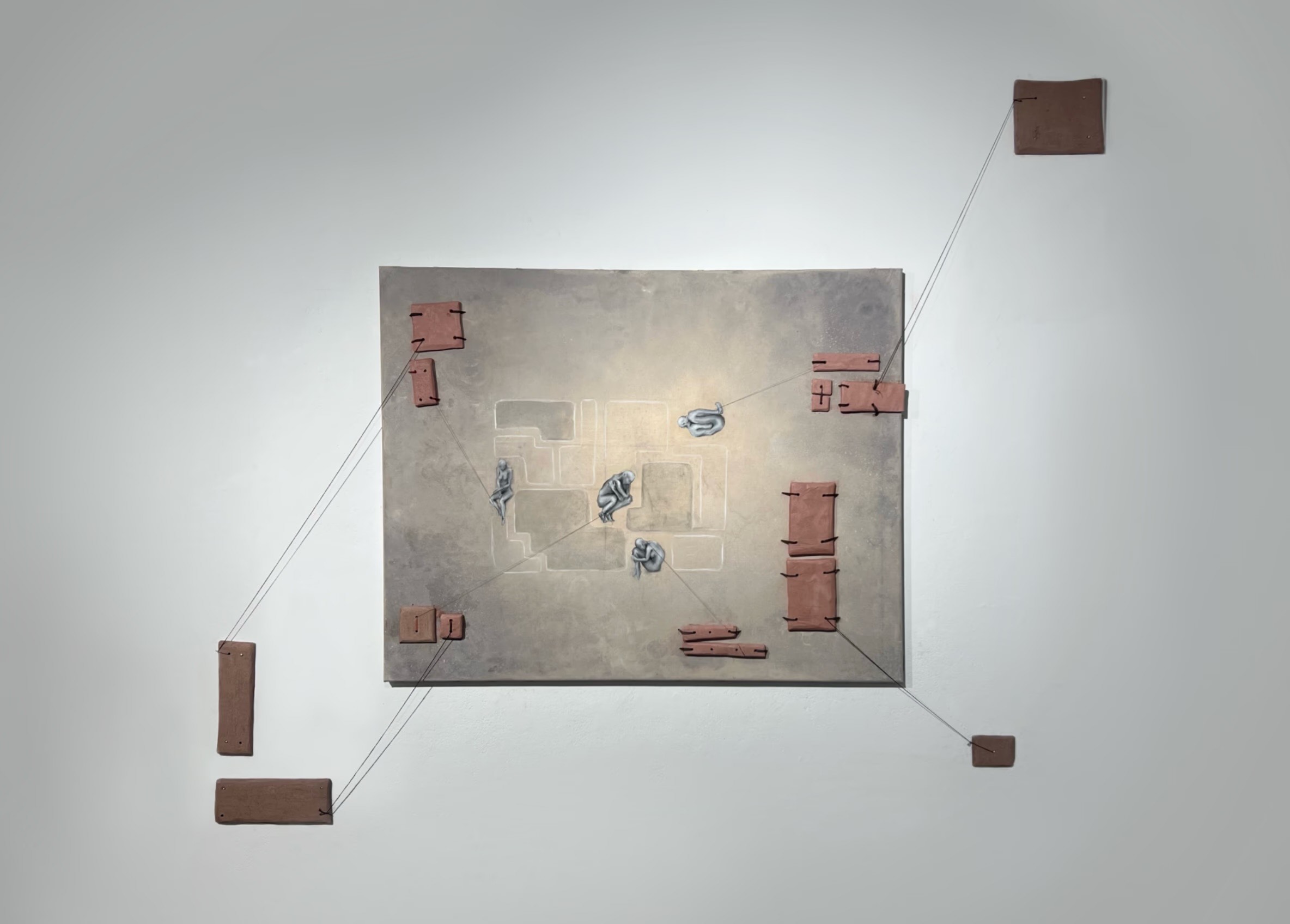
Kobe Stewart's large multimedia work explores intersecting identities. (Contributed photo)



